
PLUS FAMILIAL PAH AFFECTS 4 GENERATIONS VOLUNTEER WORK BRINGS PERSONAL GROWTH Keeping Fundraisers Fresh A publication of the Pulmonary Hypertension Association 2022 // Volume 31 // No. 4 Finding Hope THROUGH DEVASTATION
The Navigating PAH Pathways program offers free webinars created specifically for patients and caregivers, all led by a PAH Nurse and sponsored by Janssen.*



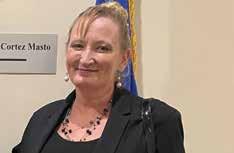
Find Answers















Hear an educational presentation from a PAH nurse on topics that may be important to you.


Why Understand more about the effects of PAH, the 3 key treatment pathways, and treatment goals.
All webinars are viewed on a computer; internet access required. PAH=pulmonary arterial hypertension.
*The speaker is a paid consultant presenting on behalf of Actelion, a Janssen Pharmaceutical Company, and must present information in compliance with FDA requirements applicable to
















































































































Knowledge. Understanding. Empowerment.

PHASSOCIATION.ORG 3
Get
should always
information.
Life With PAH Can Be Challenging. Learning About PAH Shouldn’t Be. Join a free, educational webinar in the comfort and
of your home
Learn
Talking Discover how to have more informed conversations about PAH with your care community. Webinars are available at various dates and times so you can register for one that best fits your schedule. Knowledge. Understanding. Empowerment. Register today at PAHregister.com or call 1-888-370-8111 Your PAH healthcare team
be your main source of
This program is not intended to provide medical advice or address specific medical concerns. This program is sponsored by Janssen Pharmaceuticals, Inc. ©2021 Actelion Pharmaceuticals US, Inc. All rights reserved. cp-201358v1 0121
safety
Actelion, a Janssen Pharmaceutical Company. 2022 // VOLUME 31 NO. 4 IN THIS ISSUE 7 How We ‘PHaced’ the Future To Raise PH Awareness 8 Familial PAH Affects 4 Generations 10 PTE Surgery Discovers ‘Young Heart’ 14 How PH Legislative Advocates Work for Change 15 5 Insurance Tactics To Prepare for the New Year 17 Volunteer Work Brings Personal Growth 18 Finding Hope Through Devastation 25 Take Advantage of Patient Platform for Online Learning 28 PH Professionals: Help Shape Patient and Continuing Education 29 PHA Expands Professional Mentorship Program 30 Keeping Fundraisers Fresh ON OUR COVER Emily Wahl of Mandeville, Louisiana, takes a break from her career while managing pulmonary hypertension and grief. This issue explores the many facets of growth for PHA and its members. IN EVERY ISSUE 5 Letter From the Chair 31 Calendar 32 Quick Takes 34 Passages 30 10 PHacing THE FUTURE November is Pulmonary Hypertension Awareness Month 7 8 18 14
PUBLISHER
Matt J. Granato President & CEO
STAFF
 Linda Busche Editor-in-Chief Paula Maturana Graphic Designer Karen Smaalders Vice President, Communications and Marketing
Linda Busche Editor-in-Chief Paula Maturana Graphic Designer Karen Smaalders Vice President, Communications and Marketing
CONTRIBUTORS
Danielle Clement, Naya Baharona, Sara Bloomgarden, Angela Golden, Lauren Intrieri, Daniel Layton, Zangi Miti, Mike Porter, Abby Sickles, Jaeger Spratt, Elizabeth Stewart, Sara Tyghter, Emily Wahl, Whitney Whited. Cover story photos by Scott Saltzman/ Barefoot Photography.
CONTACT
301-565-3004 PHAssociation.org
SUPPORT LINE
800-748-7274
We’re here to support anyone with a connection to PH. (daytime, please)
Submissions to Pathlight are welcome. Please email your articles, photos and queries to Communications@ PHAssociation.org.
Headquarters
1629 K St., Suite 300 Washington D.C., 20006
Billing and Mailing Address
8401 Colesville Road, Suite 200 Silver Spring, MD 20910
BOARD OF TRUSTEES
Tony Lahnston, chair Traci Stewart, chair-elect Matt Wall, treasurer
Colleen Brunetti, M.Ed., C.H.C., immediate past chair
Nicole Creech, secretary
Matt J. Granato, L.L.M., M.B.A, president and Ceo, ex officio
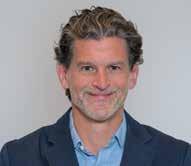
Trustees-at-Large
Colleen Connor
Ramona Doyle, M.D., M.Sc.
Anna R. Hemnes, M.D.
Kimberly Jackson, R.N., B.S.N. Mitch Koppelman, Ph.D.
Michelle Ferdinand Liu, M.D., M.P.H., FAAOA
Monica M. Penaranda
Diane Ramirez
Doug Taylor
Jessie Kohler Wenninger, Esq. Delphine Yung, M.D.
Emeriti ex-officio
C. Gregory Elliott, M.D., FCCP, MACP Michael D. McGoon, M.D. Edwin Simpson Judith Simpson, R.N., Ed.S. Honorary Carl Hicks President & CEO Matt J. Granato, L.LM, M.B.A
PH PROFESSIONAL NETWORK EXECUTIVE COMMITTEE
Kimberly Jackson, R.N., B.S.N., chair
Cheri Abbott, R.N., CCRP
April Blakley, R.N., B.S.N.
Jessie Dunne, PharmD, BCPS, BCCP
Loida A. Johnson, CRNP
Tisha Kivett, R.N., B.S.N.
Melissa Magness, M.S.N., APRN, CNP-AC, chair-elect
SCIENTIFIC LEADERSHIP COUNCIL
Anna R. Hemnes, M.D., chair
Steven H. Abman, M.D.
William R. Auger, M.D.
Eric D. Austin, M.D., MSCI
Sonja Bartolome, M.D.
Todd M. Bull, M.D., chair-elect
Murali M. Chakinala, M.D., FCCP, immediate past chair
Kelly Chin, M.D.
Vinicio A. de Jesus Perez, M.D., FCCP
Teresa De Marco, M.D.
Ankit A. Desai, M.D., FACC, FAHA
Jeffrey Fineman, M.D.
Robert P. Frantz, M.D.
Mardi Gomberg-Maitland, M.D., M.Sc.
Daniel Grinnan, M.D.
Kristin B. Highland, M.D., MSCR
Tim Lahm, M.D.
Deborah J. Levine, M.D.
Wes McConnell, M.D.
Lana D. Melendres-Groves, M.D.
John J. Ryan, M.D., M.B., B.Ch., B.A.O.
Sandeep Sahay, M.D.
Oksana A. Shlobin, M.D., FCCP
Thenappan Thenappan, M.D.
Nidhy Varghese, M.D.
Corey E. Ventetuolo, M.D., M.S.
R. James White, M.D., Ph.D.
Timothy L. Williamson, M.D.
Liaisons
Anna R. Hemnes, M.D., Kimberly Jackson, R.N., B.S.N.
Distinguished Advisers
David B. Badesch, M.D.
Erika S. Berman Rosenzweig, M.D. Bruce H. Brundage, M.D.
Richard Channick, M.D.
C. Gregory Elliott, M.D., FCCP, MACP
Karen A. Fagan, M.D.
Michael D. McGoon, M.D.
Vallerie V. McLaughlin, M.D. John H. Newman, M.D. Ron Oudiz, M.D.
Dear PHA community:
LETTER CHAIR from the
As the Pulmonary Hypertension Association (PHA) focuses on growth in the coming years, the theme of the winter issue of Pathlight is growth.
There is no growth without change. Life continues around us on a daily basis and is constantly changing. We all must accept growth by embracing change.
While PHA has experienced significant growth since it was founded in 1991, it remains focused on its vision, mission, and who we are as an organization.
A great example of this growth is the Pulmonary Hypertension Care Center initiative that started in 2015 and has grown to 82 PHA-accredited care centers throughout the United States. We are proud of this accomplishment and look forward to continued growth, improved treatment for our patient community, and new research.
This issue of Pathlight recounts the many ways the pulmonary hypertension (PH) community has grown as patients manage their disease. In our cover story, Emily Wahl relates how her life was upended when her newborn daughter was diagnosed with PH and later died. In that time, Emily had a blood clot that led to her own PH diagnosis. Yet, Emily, 31, hopes to return to a career as an orthopedic physical therapist.
In “Familial PAH Affects Four Generations,” Whitney Whited shares her family history with pulmonary arterial hypertension (PAH). Learning about the BMPR2 gene has pushed her to seek genetic testing for her and her children, as well as work for more awareness about heritable PAH.
We hear from Mark Porter in “PTE Surgery Discovers a Young Heart.” Mark, 49, developed large blood clots despite his active lifestyle and eventually was diagnosed with chronic thromboembolic pulmonary hypertension. As he
recovers from his August surgery, he’s making plans for ski trips this winter.
This issue’s donor profile relays how Janet McAllister is “Keeping Fundraisers Fresh.” Janet’s Paddle the Gallup canoe race and barbecue evolved from the Halloween fundraising event she started after her 2011 PAH diagnosis. Fundraising has become a way for Janet to increase knowledge about PH.
In "Volunteer Work Brings Personal Growth," six volunteers share how they have grown as leaders and selfadvocates by providing peer support for the PH community. We also hear from five advocates who help the PH community grow its power on Capitol Hill.
The issue also includes stories about PHA’s expanded professional mentorship program, tips to be your own care advocate, and ideas on how to prepare for the New Year.
Although I hate to see the days slip by as the year comes to a close, I look forward to a wonderful year of growth for PHA in 2023!
I hope for growth in this wonderful organization that not only values it’s patients, caregivers, medical community and supporters but also truly values those that make PHA the successful and caring organization it is: the amazing staff.
Here’s to another year of achievements towards our goal for a cure.
Tony Lahnston Chair, Pulmonary Hypertension Association
PHASSOCIATION.ORG 5 4 PATHLIGHT
How We ‘PHaced’ the Future To Raise PH Awareness
As Pathlight was going to press, the Pulmonary Hypertension Association (PHA) had recently kicked off its annual Pulmonary Hypertension Awareness Month campaign.


This year’s theme was “PHacing the Future Day by Day.” In November, PHA educated people about risks factors and symptoms of pulmonary hypertension (PH) through its award-winning, interactive online PH Awareness Month calendar. The calendar revealed a new fact or tool daily, along with downloadable resources to raise PH awareness.
“PHA and the entire PH community have made great strides over the years in creating awareness of this disease,” said PHA Board of Trustees Chair Tony Lahnston. “We continue that trajectory and face a bright future with improved support, diagnosis and treatment of PH through education, expanded resources

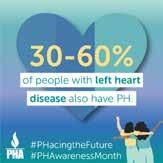
and dedicated research. PHA staff and leadership remain committed to PHA's mission to extend and improve the lives of those affected by PH.”
Our awareness month digital toolkit included shareable resources, such as social media profile and cover photos, social media graphics, an email signature and sample social media posts.


The toolkit also included graphics and sample social media posts for PHA’s Day of Action on Nov. 17. This year, we encouraged the PH community members to sign the American Lung Association’s oxygen reform petition. The petition urged Congress to implement reforms that would improve access to supplemental oxygen.
PH patients, caregivers and others found additional ways to take action, such as sharing oxygenaccess experiences and visiting PHA’s Advocacy Action Center.
This year’s events included the Nov. 15 PHA Live webinar “Focus on PH Research.” Anna Hemnes, M.D., Evan Brittain, M.D., M.Sc., of Vanderbilt University Medical Center, and other panelists discussed research advancements presented at PHA 2022 International PH Conference and Scientific Sessions in Atlanta.
As part of PH Awareness Month, PHA marked Nov. 9 as CTEPH Awareness Day.
Chronic thromboembolic pulmonary hypertension (CTEPH) is a rare form of PH caused by blood clots in the lungs that harden over time and impede blood flow. [See Mark Porter’s first-person account of his CTEPH journey and PTE surgery, Page 10.]
PHA also celebrated GivingTuesday on Nov. 29 as part of its PH Awareness Month activities.
PHASSOCIATION.ORG 7 NEWS
PHAssociation.org Contact: Advertising@PHAssociation.org PULMONARY HYPERTENSION ASSOCIATION Advertise in: Pathlight: PHA’s quarterly member magazine PHAssociation.org: Comprehensive resource for anyone affected by PH PHA News: Biweekly patient-focused e-newsletter Reach members of the
Familial PAH Affects 4 Generations
WHITNEY WHITED was 10 when her father died of pulmonary arterial hypertension (PAH) complications. Recently, she learned about the BMPR2 gene and sought genetic testing for her 11-year-old daughter, EllieRay. Whitney, 34, who doesn’t have PAH, knew several family members had died from PAH or were suspected to have had it. She and her fiancé Zachary Hillson also are considering genetic testing their 4-yearold son Carter.
BY WHITNEY WHITED
My family has a long history of aggressive genetic PAH. My father, Roger Whited, passed away in 1999 from complications of his PAH three years after his diagnosis. One of my father’s first symptoms was frequent bloody noses. I’m not certain of the medication he was on, but I remember he wore a box-like machine that stored ice packs where he inserted his medication. A rather large tube ran from the box directly to his chest into his heart. He had to take the tube everywhere with him.
Since I was so young, I have only my memories of my family’s experience with PAH, rather than paperwork and names. I know that this all starts with my grandparents, and we believe the earliest PAH diagnosis in our family was in 1969.
FAMILY HISTORY
Most likely, my grandfather, James Whited, died due to PAH; his diagnosis was never confirmed. My grandparents had three children: my father and my aunts Shirley and Nancy Whited. Shirley’s death also was thought to be due to complications of undiagnosed PAH.
Nancy had two children, Jody and Jill Davis. Jill was diagnosed with PAH at 39 and passed away three years later. Jill’s son, Timothy, passed at 32 years old after a PAH diagnosis later in his life. Jody’s son Raymond was the youngest person in our family who was diagnosed with PAH. He passed at age 12.
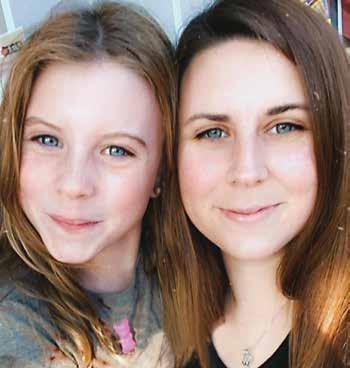

SEEKING TESTING
Because of my family’s previous history, I had my daughter get an echocardiogram. We found out that she has a large fibroma tumor in her left ventricle. I was completely taken aback. My main worry was that the doctors would find PAH, too.
As of now, EllieRay is stable with no known PAH. We are awaiting gene mutation results related to the tumor. The only problem is that we have no records of my family’s history.
In the months waiting for tests to rule out EllieRay’s PAH, I started gathering more information about PAH and my family’s history. When I found out about the BMPR2 gene’s connection to PAH, I asked for her to be tested. I’ve been researching this disease and pushing for awareness ever since.
EMPOWERED BY HOPE
At first, I wasn’t hopeful when I learned of my family’s PAH history. But through research, I’ve found others online who live with PAH and even those who received lung and heart transplants. Knowing there are others living with PAH gives me hope.
Though my father never had the opportunity to have a transplant, I’m hopeful others in my family will be able to if they receive a PAH diagnosis.
I haven’t met any family members who survived their PAH, but none of them made it to a transplant either. I would love to discuss and compare family stories and progress so we can help our babies and our babies’ babies.
PHASSOCIATION.ORG 9 8 PATHLIGHT FEATURE FEATURE
EllieRay (left) and Whitney Whited
EllieRay, Zachary Hillson, Whitney Whited and Carter in 2017
James Whited
Nancy Whited
Jody Davis Marry Ann Jill Davis
Shirley Whited Roger Whited
Raymond Davis
Timothy Harmon
WHITNEY'S RELATIVES WHO DIED FROM PAH
PTE Surgery Discovers a ‘Young Heart’
BY MARK PORTER
In July 2020, I started to feel short of breath. I was 46 years old and considered myself to be in shape. I had been exercising and weight training consistently four or five days a week for 15 years. My primary care doctor prescribed an inhaler and lung steroids to help my breathing. By October, the treatments weren’t providing any relief.
As I sat down to eat, my doctor called my cell phone in a panic, asking where I was. I told him I was at home. He asked my wife to immediately drive me back to his office to discuss the CT scan.
be on the medication for six months and be back to normal within a few months.
MARK PORTER, 49, LIVES IN REXBURG, IDAHO, WITH HIS WIFE OF 25 YEARS, ERIN. THEY HAVE THREE SONS: COLTON, 22; CARSON, 19 AND CALEB, 16.

MARK OWN PORTER’S OFFICE PRODUCTS AND ENJOYS WORKING OUT, SKIING AND WATER SKIING.
Mark and Erin Porter
In early November 2020, I developed a limp and couldn’t figure out why my right calf was swelling. By Thanksgiving week, I couldn’t walk. After trying a heating pad and a TENS machine, I consulted the internet, which told me I had blood clots, and immediately made an appointment with my doctor.
My doctor examined my right calf and ordered an ultrasound at the local hospital. He asked me to come back to his office at 2 p.m. to review the results. I left his office and directly went to the hospital for the ultrasound. The technician could see something between my knee and my ankle and called my doctor.
Two hours later, I had a CT scan. The administering nurse told me to go back to my doctor’s office, about two blocks away, to discuss the results.
When I went back, the doctor was out for lunch. I went home to change and eat before returning for my original appointment at 2 p.m.
While waiting in the exam room, my wife and I could hear a conversation my doctor was having on the phone. He was letting a hospital on the other line know that I was stable and ready to be transported. Panic set in for my wife and me. We were hearing a one-sided conversation and had not yet discussed my results.
IDENTIFYING BLOOD CLOTS
Finally, my doctor came in. The CT scan revealed a large deep vein thrombosis in my right calf from my knee to my ankle. More alarmingly, the scan showed a large pulmonary embolism in my pulmonary artery. I was told to immediately go to a hospital 30 miles away that could handle any embolism complications.
The hospital put me on blood thinners and medication to dissolve the clots. The nurses were surprised to see how “young” I was with the condition. Many doctors came in to ask what I had done to cause the clots. They were shocked when I told them nothing.
I was released the evening before Thanksgiving and put on Eliquis to dissolve the clots. I was told I would
By December 2020 and into January 2021, I began to feel a bit better. By February 2021, I was weight training again and skiing some. I still felt short of breath, but not as bad as before. I figured it was part of the road to recovery. By summer, I felt like my recovery had plateaued.
In August 2021, I developed chest pain, shortness of breath and fatigue. I thought I had another PE. My doctor ordered another CT scan on my right calf and a stress test. The scan didn’t show anything new, and my heart looked fine. The doctor said my chest pain might just be acid reflux. I knew what acid reflux felt like, and this wasn’t it. However, I was cleared to ski and perform normal activities.
I went on a ski trip before Christmas 2021. During the trip, I
PHASSOCIATION.ORG 11 FEATURE
‘I’m so glad I continued to fight to have my appointments scheduled and never gave up. I’m confident I made the right decision to have the PTE surgery.’
struggled to breathe while skiing. By the last week of December, my chest pain was unbearable. I saw another doctor as mine was on vacation. After reviewing my previous testing, they referred me to a cardiologist.
In January 2022, I saw the cardiologist. He ordered blood work to find the reason for my initial blood clots. He also ordered several new tests like a V/Q scan and heart catheterizations. I was put back on Eliquis. After undergoing additional testing and describing my symptoms, I was referred to a pulmonologist who works with doctors at University of California San Diego.
CTEPH DIAGNOSIS
In February 2022, I met with the
pulmonologist and was diagnosed with chronic thromboembolic disease and was developing chronic thromboembolic pulmonary hypertension (CTEPH).
Finally! I had been given a diagnosis of my symptoms and a plan to address it. I was so relieved when I received a diagnosis. My symptoms were real, and the doctors were there to help. The pulmonologist said he would send his referral to UCSD that week. I was told to stop weight training and to only lightly exercise.
In May 2022, I received a call from Nick Kim, M.D., at UCSD. We talked about my symptoms and how I had been reduced to working two or three hours a day and sleeping two or three hours each afternoon.
Dr. Kim said my test results weren’t as bad as others he’d seen, but he wanted to schedule evaluations at UCSD. He said it could take 30 days to schedule the appointment because of insurance red tape, but help was on the way.
The 30 days came and went. I didn’t hear anything from UCSD. In July 2022, I called to check on the status of my insurance and schedule my visit.
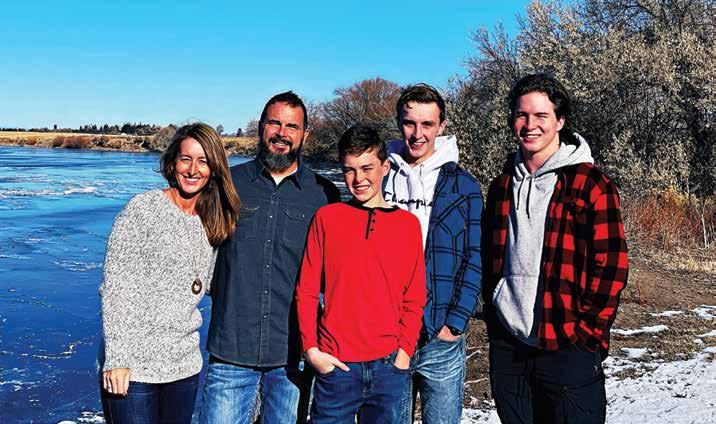
With one call, my evaluation was scheduled for Aug. 23 and my potential pulmonary thromboendoarterectomy (PTE) surgery for Aug. 30.
My wife and I drove 14 hours from our house in Idaho to San Diego. We didn’t know whether I would be
getting the surgery or when we could leave.
POSSIBLE SETBACK
I started my evaluations as scheduled and underwent many of the same tests I had in January. On Aug. 25, I met with a clinical doctor who said my numbers didn’t look bad and that my symptoms shouldn’t be as severe as they were. They said they would present my tests results the next day to confirm whether I was eligible for surgery.
This was the lowest point in my journey. I had gotten this far to be told my numbers don’t match my symptoms and that there was a chance I wouldn’t be recommended for surgery. I felt helpless. It was a long 24-hour wait.
On Aug. 26, I received a call that I was scheduled for surgery on Aug. 30. I was so grateful and overwhelmed.
PTE SURGERY
The day before surgery, I arrived at UCSD for final bloodwork and met my surgeon, Michael Madani, M.D., FACS. He was so reassuring and caring, and my wife and I were quickly put at ease about our concerns.

I told Dr. Madani that the clinic doctor had told me I might not be a good candidate. Dr. Madani assured me that I was. He had reviewed my information before I got to UCSD and knew the surgery was the right fit. That
was even more of a confidence builder.
On Aug. 30, I had my PTE surgery. Afterward, Dr. Madani said the surgery was successful but there was much more residual clotting in my lungs
An echocardiogram a week after my surgery showed inflammation around my heart. My medical team told me that was normal, and I was scheduled for another echocardiogram a few days later to see whether the inflammation had subsided. My healing progressed well over the next week, and I could take several walks a day. My second echocardiogram showed the inflammation around my heart had increased slightly. The doctors were concerned, but I was discharged and was asked to stay in the area until follow up tests could be performed the next week. On Sept. 12, I was cleared to go home.
As of Sept. 30, I completed my second week at home post-surgery and notice a big difference in how I feel.
than the testing initially indicated. My entire right lung and most of my left lung were full of clots.
Over the next couple of days, Dr. Madani regularly checked on me. He said my heart appeared similar to that of a teenager. That skewed some of my previous test results as my heart wasn’t typical for someone of my age.
ONGOING RECOVERY
I remained in the ICU until Sept. 2, when I was moved to general care.
I’m anticipating a full recovery in about three months and have planned ski trips for this winter. I’m so glad I continued to fight to have my appointments scheduled and never gave up. I’m confident I made the right decision to have the PTE surgery.
‘I was so … relieved I received a diagnosis. My symptoms were real, and the doctors were there to help.’
PHASSOCIATION.ORG 13 12 PATHLIGHT FEATURE FEATURE
Mark dines in San Diego the night before his PTE surgery.
Erin, Mark, Caleb, Colton and Carson Porter in December 2020, two weeks after Mark's pulmonary embolism.
How PH Legislative Advocates Work for Change
Since the beginning of the year, the pulmonary hypertension (PH) community has used the collective power of its voices to make a real impact with Congress.
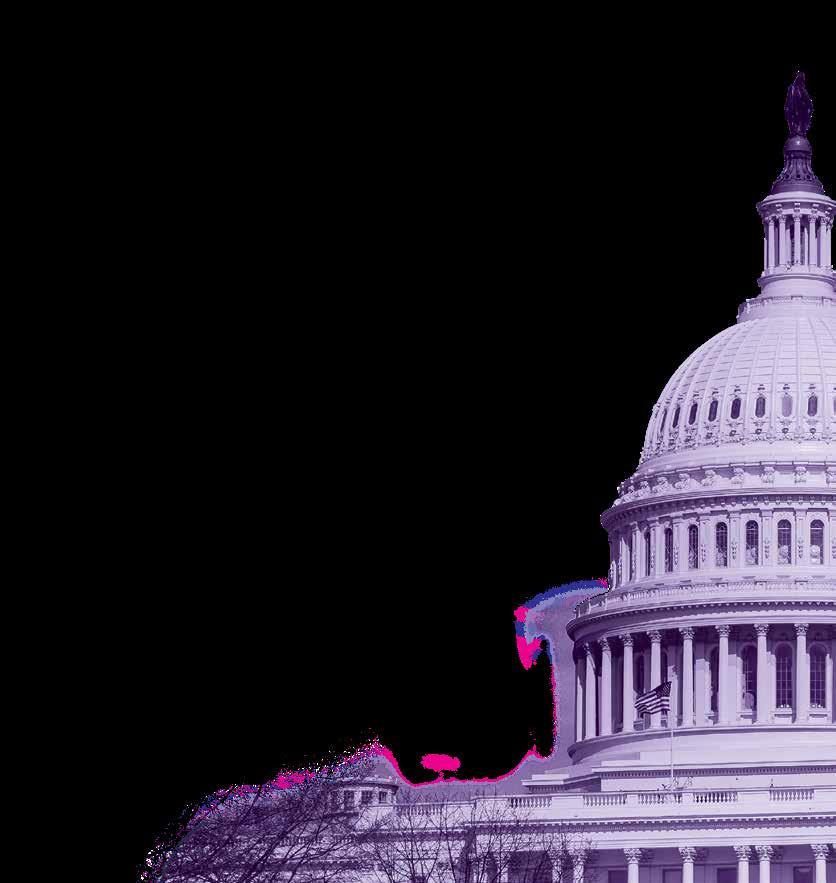
The Pulmonary Hypertension Association (PHA) World PH Day virtual advocacy event in May and its Advocacy August campaign allowed first-time and experienced advocates to meet with staff from their elected officials’ offices.
During the PHA 2022 International PH Conference and Scientific Sessions advocacy challenge, we surpassed our goal of sending 500 messages to Congress in support of the Safe Step Act: We sent 829 messages in June.
By gaining new advocates, the PH community grows its power on Capitol Hill. To celebrate the advocacy work we’ve accomplished, new and veteran advocates who share their stories:
telling your story. It's priceless to have the opportunity to speak directly to lawmakers and explain the importance of bills and proposed legislation. It’s empowering to explain to Congress why something needs to be done and to provide the solution. I let my voice be heard instead of wishing I could do something.
Advocacy is powerful, impactful and incredibly worthwhile. PHA guides who were with me during those meetings are well-versed in legal knowledge so all I needed to do was tell my story.
During the virtual legislative visits, I told each office how our son’s condition had worsened on the generic drug our insurance company made him use before it would cover the name-brand version. I mentioned how setbacks in the PH world can be catastrophic.
PHA gave me the opportunity to tell our family’s PH story and help create meaningful, direct changes in public policy impacting those with rare diseases. It's my job as a parent to protect and advocate for my son. As a dad of a child with PH, I often feel helpless and powerless. Participating in the PHA Advocacy events has allowed me to have a purpose and a feeling of empowerment.
I encourage everyone to volunteer in some capacity with PHA. It can take little time and effort on your part, but it delivers so much reward in return.
my diagnosis in 2018 in a positive way by providing policymakers with the information they need to decide on legislation that can help our community.
I have met twice with my members of Congress, Sen. Jacky Rosen and Rep. Susie Lee, both Democrats from Nevada. I also joined a virtual advocate group to talk with Rep. Mark DeSaulnier (D-Calif.). I left each meeting feeling like I mattered and that the lawmakers cared about what I'm personally going through.
If anyone is thinking about making an advocacy visit, I guarantee you will have a great opportunity to voice issues that are important to you and your health. These people care about us. To witness that firsthand is an honor.
legislature, it’s just words on paper until we voice why these issues are important and how they impact our lives.
Advocating to someone with the power to help make changes to improve our lives was unforgettable. While speaking with legislative staff, I felt that I was truly being heard. They wanted to understand what we go through and how they could help us.
Jaeger Spratt was helpful providing bill numbers and background information during the meetings to legislative staff.
Thanks to PHA, I was given this opportunity and I hope to continue with advocacy. With the power of the PH community using our voices together, we will make changes.
meet with my legislators’ offices. The legislative materials and coaching they provided gave me the confidence to speak on these subjects.
In my first, and I assure you, not my last advocacy meetings, I spoke with staff from the offices of Democratic Sens. Robert Menendez and Corey Booker and Rep. Andy Kim (D-N.J.). It was an honor to inform legislators about PH, our community and the struggles we live with every day. Hilary Caron, legislative director for Kim’s D.C. office, emailed us the day after our meeting to tell us the congressman had agreed to co-sponsor the HELP Copays Act (H.R. 2163). It feels like I made a difference.
By joining the World PH Day advocacy visits, I learned first-hand that advocacy is nothing more than
Jeffrey Harpp, Indianapolis, Indiana

My 16-year-old son Cash was diagnosed with idiopathic PH in 2015. I signed up to participate in PHA’s legislative efforts after our family attended our first PHA International PH Conference and Scientific Sessions in 2018 in Orlando. In May, I participated in PHA’s World PH Day virtual advocacy event.
Nicole Sean Hogan, Las Vegas, Nevada
Advocating with PHA is very rewarding. I can use the knowledge and experiences I’ve gained since
Patti A. Sakoman, support group leader, Raleigh, North Carolina

I lead a PHA support group with my son and caretaker, Josh Franson. When he and I volunteered to participate in PHA’s World PH Day virtual advocacy event, I had no idea it would be so personally fulfilling.


All of us struggle daily with many issues, like affording medications or insurance companies requiring us to switch to generics. When an important bill is written in Congress or the state
In June, I attended PHA 2022 in Atlanta looking for more opportunities to get involved. At the conference, I learned about PHA’s advocacy work.
When I signed up for the Advocacy August campaign, Jaeger Spratt, PHA’s advocacy and treatment access program manager, prepared me to
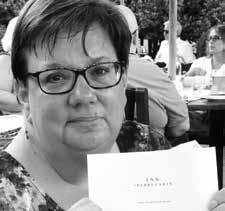
14 PATHLIGHT ADVOCACY ADVOCACY
Josh Franson, support group leader, Raleigh, North Carolina
Nancy Zeppa, South Jersey support group leader, Burlington, New Jersey
5 Insurance Tactics
To Prepare for the New Year
Set yourself up for success in the new year with steps to prevent treatment delays, especially prescription refills and prior authorization renewals.

Notify your care team. If your insurance coverage is changing in January 2023, tell your care team right away. Give your care providers plenty of time to tackle potential obstacles. Don’t wait till the new year. Many health insurance plans include prior authorization or step therapy requirements for pulmonary hypertension (PH) medication. Check whether your care team needs to complete new paperwork or file an appeal to give you seamless access to your therapy.
Order multi-month refills. Before the end of this year, ask your health care team to make your last refill of the year a 60- or 90-day refill. If you are eligible, a multi-month refill will further reduce your risk of treatment disruption in the new year.
Inform your specialty pharmacy about insurance changes. Each health insurance plan works with various specialty pharmacies to deliver PH therapy. But people with PH often are responsible for notifying their specialty
pharmacies that their health insurance has changed. Check with your specialty pharmacy to see whether a change in insurance will affect how you receive your PH therapy.
Check your drug formulary. Make sure you know which medications your insurance plan includes in its drug formulary. Even when your insurance plan doesn’t change, medication coverage can vary from year to year. Before the new year, ensure your medications will be covered as expected.
Explore financial assistance eligibility. When your health insurance coverage changes, sometimes your copay assistance eligibility changes as well. Manufacturer assistance programs, nonprofit grants and government-funded support programs have different eligibility criteria. Visit PHAssociation.org/HELP or contact PHA’s Treatment Access Program to learn about your financial assistance options. Call 301-565-3004 x758 or email Insurance@ PHAssociation.org
Thanks to Janssen Pharmaceuticals for its support of PHA’s Treatment Access Program.
Prepare for Winter Weather Emergencies
Cold months often mean snowstorms and a risk of power outages. Power outages can be serious for many people with pulmonary hypertension (PH), especially those who need home concentrators to provide continuous oxygen.

Even if you don’t rely on oxygen, make sure you have a plan for potential emergencies and natural disasters common to your geographic region.
HERE ARE A FEW TIPS TO REMEMBER:
Ask about priority reconnection service. Many power companies keep lists of customers who use lifesupport devices, such as breathing machines. The utility providers prioritize power restoration to those customers in
emergencies. Most companies have their online forms to add your name to their lists. Reach out to your power company’s customer service department and ask if the service is available.
Explore the Pulmonary Hypertension Association (PHA)’s emergency preparedness resources. PHA offers webinars, checklists and other materials to get you started: PHAssociation.org/portfolio-items/make-your-phemergency-plan.
Add These Tactics to Your Emergency Checklist: PHAssociation.org/add-these-tactics-to-youremergency-checklist.
Volunteer Work Brings Personal Growth
Pulmonary Hypertension Association (PHA) volunteers play an important role in providing peer support, educating and empowering the pulmonary hypertension (PH) community. But the experience helps the volunteers, too. Here are some ways volunteering has helped these volunteers:
Nikole DuTemple Nichols, support group leader, Reno, Nevada
Being a support group leader allowed me to explore so many aspects of PH I never would have before. I've learned so much about myself and my condition. I feel so much more confident and have been able to use my newfound knowledge and confidence to support others who have not reached that place yet in their journey.
Karen Sawyer, Lansing, Michigan
I’ve grown by being able to educate and build a community through my PHA support group. Helping others has helped me become more caring, passionate, strong and creative. It makes me very proud. It's not always easy — there are hard times and things you must deal with. But it is nice to give back by connecting with each other and sharing stories.
Jeri Nudell, support group leader, Colorado Spring, Colorado



Being a support group leader helped me improve communication with my health care team about my PH and non-PH needs. My PH team encourages me to ask questions, and we explore different treatment options all the time. I now ask tons of questions with all my physicians. I feel like I am finally leading the conversation instead of following what they have to say. I investigate all potential side effects or adverse effects before I agree to anything. I had a really hard time adjusting to my PH medication after diagnosis. I had lots of side effects that also needed to be managed. All of this comes into consideration now.
Mitzi McIver-LaBarge, Email PHriend and Facebook group moderator



It’s helped me be a better listener.
Janet Mabe Harda, PHA support line volunteer
It helped me be a better advocate for PH because so many people were sharing their journeys. I didn’t want everyone to feel the way I did when first diagnosed. When other patients shared their journeys, it prepared me for any question I might be asked, even ones that I hadn’t asked before. Everyone thinks differently and expects different results so you have to prepare yourself for things like medication victories and disappointments, doctor achievements, and results that you weren’t expecting. It all depends on where you are with our disease.
Erica Kepes, PHA Email PHriend
It has taught me so much about the disease and human nature. We're all going to need help from time to time.
VOLUNTEER WITH PHA
Interested in becoming a PHA support group leader or a virtual support volunteer? PHA provides a toolkit to get you started and helps each step of the way. Apply to become a PHA volunteer: PHAssociation.org/get-involved/volunteer.
PHASSOCIATION.ORG 17 NEWS 16 PATHLIGHT
Finding Hope Through Devastation Young mother battles Sjögren's, CTEPH and PAH
BY EMILY WAHL
I was diagnosed with Sjögren’s syndrome when I was 16. I had typical dry eyes and mouth, but that was the extent of my symptoms. At the time, I ran track and cross country and played soccer. Though I didn’t participate in organized sports after high school, I remained active.
My PH symptoms started in summer 2019 when I was 28. It was increasingly difficult to climb the stairs to my front door. I found myself breathing heavily and had to pause before getting my keys out.

I told myself, “Well, I must be getting out of shape and need to exercise more.” Then I started to notice shortness of breath during long conversations, giving a presentation and performing my daily activities. I shared my symptoms of chest pain and shortness of breath with my primary care provider and soon began my journey with specialists.
Knowing that I had an autoimmune disease, Sjögren’s was the first culprit to investigate. I had several lab tests, pulmonary function tests, echocardiograms, chest scans and exercise tests. All the tests pointed to something happening in my lungs, but I never got a definitive diagnosis.
The pulmonology, cardiology and rheumatology specialists assumed the new symptoms likely were a flare-up of my Sjögren’s affecting my lungs. My echocardiogram showed a slight increase in my pulmonary artery pressures, but I was told that the test wasn’t really accurate. The doctor said the reading was probably my normal pressure level. I was treated with a six-week course of high-dose steroids and noticed some steady improvements in my breathing.
EMILY WAHL’S LIFE WAS UPENDED LAST YEAR WHEN HER NEWBORN DAUGHTER WAS DIAGNOSED WITH PULMONARY HYPERTENSION (PH). WEEKS LATER, EMILY HAD A BLOOD CLOT THAT LED TO HER OWN PH DIAGNOSIS. SADLY, 8-MONTH-OLD RENÉE PASSED AWAY IN FEBRUARY 2022 FROM COMPLICATIONS RELATED TO PERSISTENT PULMONARY HYPERTENSION OF THE NEWBORN. EMILY, 31, WHO WAS A FULL-TIME ORTHOPEDIC PHYSICAL THERAPIST BEFORE HER OWN DIAGNOSIS, HOPES TO EVENTUALLY RETURN TO HER CAREER. SHE LIVES IN MANDEVILLE, LOUISIANA, WITH HER HUSBAND, CHANCE.
FEATURE FEATURE
COMPLICATIONS
I had a follow up chest CT scan the day before Thanksgiving 2019. For some reason, my phone wasn’t receiving calls from the doctor’s office, but thankfully, I live in a small town where everyone knows everyone, and my doctor got in touch with someone to call me. That night, I learned I had a pulmonary embolism.
I was terrified; I thought I was going to die. I was confused, though. My symptoms had improved, yet I was walking around with a pulmonary embolism.
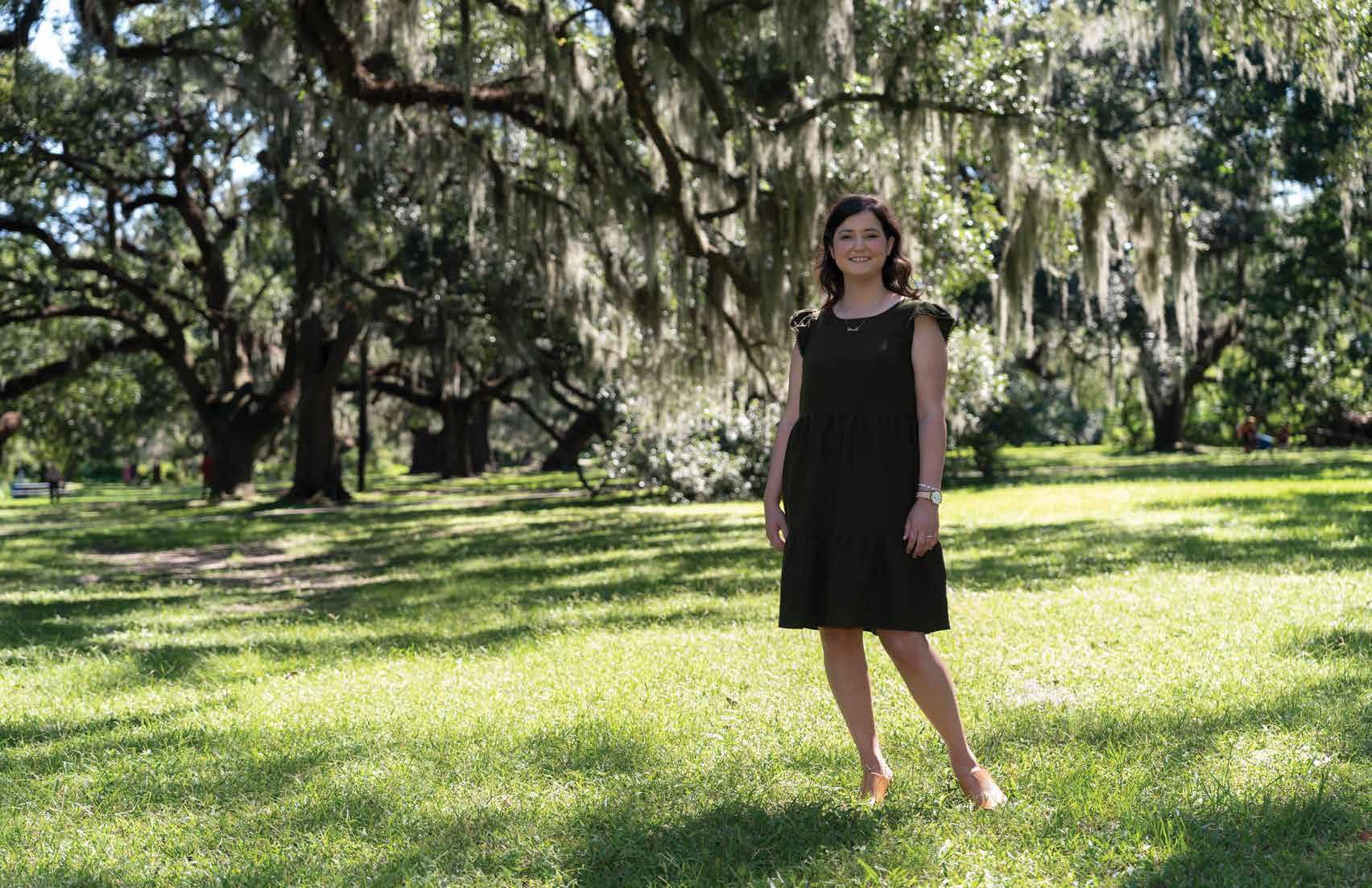
Fast forward two years later. I was pregnant with my daughter Renée. I knew it wasn’t going to be easy, but I didn’t think it was going to be as hard as it was. My immune system and body didn’t like growing another human. I developed many inflammatory reactions, along with a kidney disease, which I later found out was called focal segmental glomerulosclerosis.
My daughter, Renée, came into this world early at 26 weeks. She weighed a mere 1 pound, 1 ounce. She was born with congenital heart block, which we knew about before birth, caused by antibodies I had passed on from my Sjögren’s.
NICU LIFE
Prematurity and neonatal intensive care unit (NICU) life were a lot to learn and handle, especially while I was still trying to
heal from my own complications.
I learned about pulmonary hypertension (PH) in the NICU when my daughter was diagnosed with persistent pulmonary hypertension of the newborn.
For the majority of her short life, Renée was dependent on a mechanical ventilator. The doctors tried many pressure settings and high-flow oxygen without the ventilator. She also was prescribed nitric oxide, sildenafil and bosentan. She eventually needed a tracheostomy.
Little did I know, my own PH was exacerbating. I unknowingly had a second pulmonary embolism six weeks after Renée was born. It was found after a preoperative CT scan for a kidney biopsy.
Three months after Renée was born, I had my third pulmonary embolism. It was severe and landed me in the emergency room for an eight-day hospital stay. It was incredibly stressful and scary.
To top it off, Hurricane Ida hit New Orleans a few days after I went in the hospital. We lost our house due to hurricane damage in the midst of our time at the hospital.
CONFRONTING CTEPH
During that hospital stay, I was diagnosed with chronic thromboembolic pulmonary hypertension (CTEPH). Two pulmonologists visited me in the intensive care unit to tell me they
FEATURE FEATURE
believed I had CTEPH. They had looked through all of my records and found other embolism remnants and heart strain that I had no idea existed.
They referred me to a specialist, who confirmed my diagnosis. I underwent a six-minute walk test, brain natriuretic peptide test, pulmonary ventilation and perfusion scan, and echocardiogram. After doctors confirmed my CTEPH diagnosis, I started on Adempas and learned about pulmonary thromboendarterectomies (PTE).
I remember crying in the doctor’s office when I received my diagnosis. The doctor showed me how bad my heart was and how my tests compared
to someone my age. I was lugging around an oxygen tank and using 3 liters at the time.
I was terrified. I was supposedly young and healthy, but how could this happen to someone so young? Whenever you search anything about PH, it is pretty scary and surreal. Your future is so unknown.
TREATMENT DISAPPOINTMENT
I was referred to UC San Diego Medical Center for PTE surgery in April 2022 , barely three months after Renée died. I was overwhelmed and but excited to get treatment and a cure. I was ready to breathe air into my lungs again and live my life without thinking


of my limitations.
I underwent all the testing, and on the final day of my right heart catheterization, I learned I was no longer a candidate. My pulmonary pressures had risen significantly since
my prior tests, and my scarring didn’t equate to the severity of the pressure.
I was in right heart failure and fluid overload. I was completely devastated. I learned then that I might also have pulmonary arterial hypertension (PAH) caused by my Sjögren’s syndrome.
The PTE surgery was supposed to fix everything. I went from thinking I was going to be unstoppable to thinking I would die if I walked too far. I was scared to move, scared to breathe wrong. I had no idea how I ended up in this situation.
I thought to myself, “How am I possibly this sick?” I was so used to living with these symptoms that they became my new normal. I didn’t know any different. I was in denial.
ENVISIONING A POSITIVE FUTURE
I returned home, worried and desperately eager to begin something to make me feel better. I decided to move forward with subcutaneous remodulin. Six months later, I am feeling better. I no longer feel my heart beating out my chest; I have more energy; and for the first time, I can see a positive future.
I am looking forward to a new chapter and a new beginning. As difficult as it is, I am thankful to finally have the diagnosis.
My life has changed drastically since my CTEPH and PAH diagnoses. I no longer can work my dream job, but going back to work appears promising for the near future. I loved to travel, but now I must contemplate whether packing up all my gear to leave the house for one night is worth it. I think about where I will park before I go somewhere. I turn down outings because I’m too tired or the activity will be too much to handle.
A year since diagnosis, I’m still learning a lot. I have started pulmonary rehab and can do much more than I thought I could just six months ago. I finally am hopeful for the future.
I don’t let CTEPH and PAH keep me from setting goals. I am still new to this, so it may take years or weeks to reach them. That part I am unsure of.
Having PAH forced me to recognize other likes and talents that I never had time for. PAH has made me slow down, but in a good way.
SOURCE
OF HOPE
Finding the Pulmonary Hypertension Association and learning others’ stories gave me motivation. It gave me hope. No one around me has this diagnosis. Rarely, if ever, do I see anyone walking around with a pump or central line attached to them.
Knowing other people out there are like me makes me want to fight even harder. Seeing other peoples’ experiences, the joy they still have, the activities they can still perform, allows me to set goals and strive to achieve them.
This is a hard diagnosis, especially for young people. We are supposed to be living carefree lives, traveling, and being spontaneous. That is hard to do when you are always attached to a lifeline. We must rely on each other and lift each other up. No one else is like us because no one else is as strong as us.
Inspire and give hope to the PH community by sharing your experience with PH. Submit your story and read more personal accounts from people with PH at PHAssociation.org/ therightheart.
PHASSOCIATION.ORG 23 22 PATHLIGHT FEATURE FEATURE
‘Knowing other people out there are like me makes me want to fight even harder. Seeing other peoples’ experiences, the joy they still have, the activities they can still perform, allows me to set goals and strive to achieve them.’
Chance, Emily and baby Renée.
How Are Blood Clots Linked to PH?
Aparticularly rare form of pulmonary hypertension (PH) is caused by old blood clots in the lungs. Chronic thromboembolic PH (CTEPH), has many similar symptoms to other forms of PH: shortness of breath, fatigue and chest pain.

In CTEPH, clots impede blood from flowing through the lungs and cause the right side of the heart to pump much harder, which can lead to right-heart failure and death.
For many people with blood clots, prescription blood thinners can restore blood flow to the lungs and prevent development of CTEPH. However, a small percentage can still develop CTEPH even with the use of blood thinners. For those people, problems arise when some old blood clots obstruct large blood vessels in the lungs.
However, CTEPH can develop in another way: through changes in the small blood vessels in the lungs that are similar to pulmonary arterial hypertension (PAH). The small blood vessels become increasingly narrow and stiff in those cases. It’s also possible for CTEPH to develop from multiple small clots over a long period of time, as opposed to one or two large blood clots.
Learn more with these resources from the Pulmonary Hypertension Association:
Treatment videos: PHAssociation.org/about-cteph/ treatment.
PH & CTEPH brochure: PHAssociation.org/PHACTEPH.pdf
Ask the Expert: CTEPH recordings in English and Spanish: PHAssociation.org/ask-the-expert-cteph.
What You Need to Know After a Pulmonary Embolism brochure: PHAssociation.org/PE-brochure.pdf.
CTEPH Telephone Support Group: PHAssociation.org/telephonesupport/ctephtelephone-support-group.
THROMBOEMBOLIC DISEASE
What You Need to Know After a Pulmonary Embolism
Take Advantage of Patient Platform for Online Learning


Living with pulmonary hypertension (PH) or any chronic illness isn’t easy. But the Pulmonary Hypertension Association provides easy-to-use resources on treatment, coping skills and research through PHA Classroom.
PHA works with PH professionals to develop videos and worksheets for the online learning platform to make sure the information is up to date and scientifically vetted.
For example, PHA Classroom offers easy-tofollow videos, such as “What is PH?” and “PH 101: Understanding Diagnosis.” The detailed overviews help people with PH understand various aspects of their condition and refresh their knowledge, whether they were recently diagnosed or have had PH for several years.
PHA Classroom also offers videos and education materials about HHT, sarcoidosis, congenital heart disease and other associated conditions. This fall, PHA Classroom added a six-part video series on the relationship between PH and connective tissue disease presented by Stephen Mathai, M.D., M.H.S., of Johns Hopkins University.
Jenny Olitsky, of Orange County, California, uses PHA Classroom resources to stay informed about her disease and educate others. Jenny was diagnosed with pulmonary arterial hypertension in 2018 and hereditary hemorrhagic telangiectasia in 2005 through genetic testing.
“Having others understand … your disease is the first step to growing your care,” she says. “With resources on PHA Classroom, your family, your loved ones, friends, employers and colleagues get a better understanding from experts of what exactly is going on with your disease.”
Visit PHAssociation.org/Classroom for more information.
PHASSOCIATION.ORG 25 24 PATHLIGHT HEALTH MATTERS HEALTH MATTERS
Regional Workshop Brings PH Education to Louisville Area


More than 70 members of the pulmonary hypertension (PH) community gathered Sept. 17 in Louisville, Kentucky, for PHA On the Road. The free, daylong workshop provided patients, caregivers, family members, health care professionals and industry sponsors with timely information about living with and managing PH.
Throughout the day, expert PH specialists provided the latest treatment, research and disease-management information. Patients and caregivers shared helpful information and their experiences living with PH.
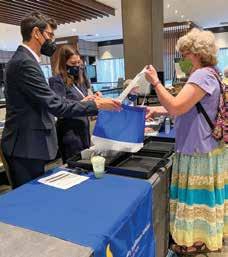
After opening remarks by co-chairs J. Wesley McConnell, M.D., and Kimberly Jackson, B.S.N., R.N., attendees learned the basics of PH during a “PH 101” presentation given by Christina Berringer, M.S.N., APRN, FNP-BC, AGACNP-BC. The presentation provided an overview of PH diagnosis and treatment, including common symptoms and diagnostics tests. The session also covered the experience of receiving a PH diagnosis and choosing appropriate treatments and therapies for each situation.
“Education is the key to empowering [patients] to take control of their care needs,” Kimberly said. “It is essential that our patients be advocates for their health.”
The workshop also featured two rounds of breakout sessions. Breakout session topics ranged from balancing
sodium and fluid intake to communicating with emergency care providers.
EXPERT ADVICE
At the networking lunch, patients and families had the opportunity to ask medical professionals questions. The panel, featuring from breakout session speakers, provided insight on self-advocating for new medications, identifying financial resources to pay for medications, the importance of participating in clinical trials, and more.
For those who missed the in-person event, PHA will offer recordings of select sessions on PHA Classroom.
Look for PHA On the Road in a city near you next year. PHA will return in spring 2023. Visit PHAssociation.org/ontheroad.
It’s important to understand the type of pulmonary hypertension (PH) you have so you take control of your care. The most common self-advocacy obstacles are a lack of knowledge and confidence in yourself, says Nikole DuTemple-Nichols, PHA support group leader.


Nikole, fellow support group leader Diane Ramirez, and immediate past PHA Board of Trustees chair Colleen Brunetti shared tips to “Get What You Need by Finding Your Voice” at PHA 2022 International PH Conference and Scientific Sessions in June. The session was designed to help patients become equal players with health care providers on their care teams. Your doctors aren’t with you day in and day out, so the knowledge you bring to the table is just as important as the knowledge of your care team, Colleen says. Discover other ways to find your voice:
Embrace your emotions and find support. Emotions can interrupt self-advocacy, and you might feel afraid to speak out, Diane says. Sometimes fear and nerves don’t go away, and that’s OK. Once you’ve advocated for yourself, you can remind yourself that you did it before and you can do it again. It’s also important to have a support system that can help empower you, whether that’s your family, friends or a PHA support group.
Listen to your body. The more you listen to your body and speak up, the more you’ll find your voice, Nikole says. Self-advocacy is knowing when you need to rest and communicating that with your loved ones. Be honest with yourself about how much you can do. Find the things that make you feel whole, empowered, rested and feed your soul. Those things are just
as much part of your care as your medication, and they’ll help you feel as good as possible while you fight PH.
Download PHA’s Empowered Patient Toolkit
PHA’s Empowered Patient Toolkit has everything you need to prepare for your PH appointments. Various forms help you track medication dosages, insurance coverage and test results. You can download and print the forms in case you want to share them with your care team or a new doctor. Find the Empowered Patient Toolkit at PHAssociation.org/patients/livingwith-ph/empowered-patient-onlinetoolkit.
Remember: It’s a good idea to have a medical bracelet with your emergency contact, medications and treatments that could interfere with your PH or a treatment you’re on.
PHASSOCIATION.ORG 27 26 PATHLIGHT HEALTH MATTERS HEALTH MATTERS 27 PATHLIGHT
‘Education is the key to empowering [patients] to take control of their care needs. It is essential that our patients be advocates for their health.'
4 Tips To Be Your Own Care Advocate 4
Kimberly
Jackson, B.S.N., R.N.
1 3 2
Nikole DuTemple-Nichols
Colleen Brunetti
Diane Ramirez
PH Professionals: Help Shape Patient and Professional Education
The Pulmonary Hypertension Association (PHA) seeks health care professionals and researchers to joins its pulmonary hypertension Professional Network committees.

PHPN committee members advance the collaborative approach to quality PH care. Nurses, nurse practitioners, pharmacists, respiratory therapists, physician assistants, social workers and other health care professionals work with PHA staff to develop innovative education initiatives and resources.
Committee members provide unique, useful resources to hone professional members’ knowledge, improve patient care and educate patients.
WHICH COMMITTEE IS RIGHT FOR YOU?
Patient and Caregiver Education Committee
• Plans, develops and advises on the creation, dissemination and analysis of a regular patient and caregiver needs assessment.
• Creates, reviews and edits new and existing educational resources for PH patients and caregivers.
• Provides tools to help patients more easily manage and communicate about their disease.
• Communicates key learning objectives and provides advice for dissemination of patient and caregiver education resources.
This committee is ideal for patient
or professional PHA members who are passionate about empowering PH patients and caregivers through educational resource development.
Professional Education Committee
• Develops in-person and digital educational resources for PH providers.
• Provides expertise and advice on topics, curricula and presenters on PHA priority topics.
• Identifies knowledge gaps among health care professionals.
• Recommends mentors to lead regional or one-to-one telementoring groups.
This committee is ideal for PHA members who are passionate about professional education design.
Practice Committee
• Creates and updates practice tools or clinic use and resources to help PH professionals provide quality patient care.
• Identifies best care practices and informational needs among the PHtreating community.
• Works closely with other PHPN committees to curate practice resources, including patient education materials, for use by PH-treating health care professionals.
This committee is ideal for PHA members who are passionate about improving the quality of patient care across all disciplines.
Symposium Committee
• Plans professional education for
PHA’s biennial PHPN Symposium.
• Invites speakers and conceptualizes new programming for PHPN Symposium.
• Creatively introduces new networking opportunities for PHPN Symposium.
This committee is ideal for members who are passionate about creating meaningful continuing education and networking opportunities for their peers.
PHPN Executive Committee
PHPN Leadership includes the chair, chair-elect and immediate past chair of the PH Professional Network. The Executive Committee includes the chairs of each of the Professional Education, Patient and Caregiver Education, and Practice and Symposium committees and the Symposium Committee vice-chair.
Learn more at PHAssociation.org/ medicalmembershipnetworks/ phpn.
PHA Expands Professional Mentorship Program
The Pulmonary Hypertension Association (PHA) is expanding its Professional Mentorship Program beyond allied health professionals to include physicians and researchers. PHA’s Professional Mentorship Program is designed to enhance patient care and professional collaboration. It pairs health care professionals new to Change to pulmonary hypertension (PH) with more experienced professionals.
Newer PH professionals might want general guidance and advice on PH-related treatment, care and research. Or they might want specific guidance on a particular topic.
The mentorship program also allows newer PH professionals to expand their relationships with other seasoned PH providers. Mentors and mentees often meet at PHA’s International PH Conference and Scientific Sessions, where mentors introduce mentees to other PH professionals and expand their networking options says Martha Kingman, FNP-C, DNP, a current mentor.
SAVE THE DATE
PHA’s PH Professional Network Symposium is set for Sept. 28-30, 2023, in Arlington, Virginia. PHPN Symposium brings together more than 400 PH-treating health care professionals every two years to learn about advancements in PH treatment and research, earn continuing education, and network. Registration will open in March 2023.
Rebecca Cox, FNP-C, was the only advanced practice provider caring for PH patients. A PHA mentor allowed her to bounce ideas off an expert from a PHAaccredited PH Care Center and get a feel for how the center handled specific situations.

“Not only did I grow in my knowledge of pulmonary arterial hypertension, but I also developed a professional relationship with my mentor.”
She continues to collaborate with her mentor years later about lung transplant patients.

Her patients have benefited from the mentorship program because they received the highest level of care. “Even if they didn’t know it, we were working together behind the scenes years after the mentorship ended,” Rebecca says.
HOW TO APPLY
Mentors and mentees submit their CVs, areas of expertise or areas of interest to PHA. PHA’s Professional Education Committee reviews the applications and selects mentor/ mentee pairs. PHA staff facilitate initial connections and follow-ups up to six months.
If you’re a member of PHA’s PH Professional Network or PH Clinicians and Researchers, you can apply for the PHA Professional Mentorship Program. Visit PHAssociation.org/medicalmembershipnetworks.
PHASSOCIATION.ORG 29 28 PATHLIGHT NEWS
NEWS
Rebecca Cox
Martha Kingman
Keeping Fundraisers Fresh
Janet McAllister started a Halloween maze as a way to raise money for the Pulmonary Hypertension Association (PHA) after her 2011 idiopathic pulmonary hypertension (PH) diagnosis.
But she found a way to raise even more money as she refreshed the event. Seven years ago, she created Paddle the Gallup, a canoe race race and barbecue in the Ann Arbor, Michigan, area.


“This fundraising … has given me
an opportunity to keep expanding information about this disease,” says Janet, of Dexter, Michigan.
Janet is among the many people whose PH was misdiagnosed with asthma. After several years, an echocardiogram and right heart catheterization showed she was in heart failure.
“[The doctors] told us to get our things in order,” she recalls. “I never thought I would leave the hospital.”
With two teenage daughters at the time, Janet and her husband David tried to keep life and activities as normal as possible.
Eleven years later, she still works full time as a real estate agent, travels and she lives what she describes as her miracle: a mostly normal life with some lifestyle changes.
“I try to live in the present and remember what a gift I was given every day I get to watch my daughters become adults and share more memories with my amazing husband and support.”
One aspect of making memories with her family is the Paddle the Gallup fundraiser. The name refers to a calm lake in an Ann Arbor-area park. This year’s event raised about $21,000 for PHA and drew 125 people.


The McAllisters’ initial PHA fundraiser was a Halloween maze at one of their offices. The maze attracted about 50 people a year and raised just
over $6,000 in 2017, its last year.
“We switched because we thought the canoe race would be a good community gathering to socialize, enjoy a barbecue and just have some fun together,” Janet says. “The increase in donations reflects the enthusiasm. The canoers like to wear costumes and truly make it a fun event.”
The more the word spreads about the event, the more successful it becomes, Janet says. “The support of volunteers from my company and local businesses and grocery stores donating food and items for raffles makes me truly appreciate the good people around us.”
To start a community event in your area, contact Events@ PHAssociation.org.
Golfing Unites Community
After Jackson Wall was diagnosed with pulmonary arterial hypertension as a baby, his parents started a golf tournament to support the fight against pulmonary hypertension (PH).
Driving Fore a Cure has raised thousands of dollars for the Pulmonary Hypertension Association (PHA) since 2013. It continues to unite the PH community and fund research and education.
In October, the most recent event drew 136 people and raised $50,000. This year’s tournament took place at Riverwood Golf Course in Clayton, North Carolina.
“Our lives were flipped upside down when Jackson was first diagnosed,” says mom Jayna Wall. “Now we can look back and see all of the positive things that have taken place due to his diagnosis."
Just as the tournament has grown, the family has grown in its faith.“We’ve seen prayers answered and God working through Jackson and our family,” Jayna says. “We’ve met so many amazing and wonderful people through this journey.
“We’ve made a difference in the PH community by raising awareness and raising funds for research for more treatments and hopefully a cure.”
Now 11, Jackson is a patient advocate who was named PHA’s Outstanding Young PH Citizen at PHA 2022 International PH Conference and Scientific Sessions.
Jackson’s initial symptoms were as small bumps on his face that resembled bug bites. When Jayna and Matt took Jackson to the doctor, an examination revealed a previously undiagnosed heart murmur. A few weeks later, they learned he had PAH. “At first the diagnosis was devastating,” Jayna said. “We were told after his heart cath that he did not respond to the medications, so our only option would probably be a heart and lung transplant. Thankfully that was not the case.”
Today, Jayna and Matt Wall say they are proud of Jackson and continue to watch him develop into an amazing young man.“We have great hope that there will one day be a cure for PH and that he will live a long and happy life,” Jayna says.

To learn more about how to start a community event, contact Events@PHAssociation.org.
CALENDAR OF EVENTS
FEB. 18, 2023
Tampa O₂breathe Walk and 5K Al Lopez Park
MAY 5, 2023 World PH Day
APRIL 15, 2023
Southern California O₂breathe Walk El Dorado Nature Center, Long Beach
SEPT. 28-30, 2023
PHPN Symposium Arlington, Virginia
JUN. 27-30, 2024
PHA 2024 International PH Conference and Scientific Sessions Indianapolis, Indiana
PHASSOCIATION.ORG 31 FUNDRAISING 30 PATHLIGHT DONOR PROFILE
What Do You Do for Fun?
Turn Your Interest Into A PHA Fundraiser
You can make a difference in raising pulmonary hypertension (PH) for awareness by creating or hosting a community fundraiser. These important events can take place anywhere, anytime of year, and they can incorporate many activities. Although many Pulmonary Hypertension Association (PHA) fundraisers traditionally have been fundraising walks, we’re expanding the ways you can get involved.
PHA fundraisers can be any kind of community event.
For example, PHA supporters have hosted everything from lemonade stands to large golf tournaments like Driving Fore a Cure. The events are opportunities for people with PH, caregivers, family, friends and health
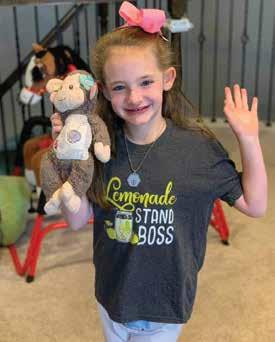
care professionals to connect and have fun while volunteering their time to raise awareness and funds to fight pulmonary hypertension.
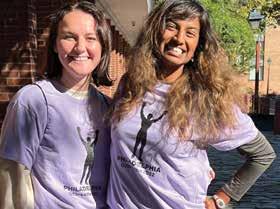
Event ideas include: bake sale, bicycle/motorcycle ride, bowling tournament, car wash, carnival, casino night, comedy show, concert, cook off, dance marathon, field day, gala, game night, golf tournament, kayaking contest, karaoke tournament, lantern launch, lemonade stand, luncheon, movie night, mud run, obstacle course, oyster roast, pub crawl, river float, scavenger hunt, silent auction, talent show, trivia night and walk/run events.
Any event is possible, and the PHA development team is here to help make your event a success. For more information, contact Events@ PHAssociation.org.
QUICK TAKES
Support Group Leaders Participate in Regional Training

Leaders from Pulmonary Hypertension Association (PHA) support groups in Ohio, Kentucky, Michigan and Indiana recently participated in a regional training summit. The Sept. 18 event in Louisville, Kentucky, was an opportunity for leaders to meet, share information and support each other. Leaders discussed respecting confidentiality, making attendees feel welcome and supported, giving everyone a chance to share, handling difficult situations, and providing education or new information.
Find an in-person or virtual PHA support group at PHAssociation.org/supportgroups. If you don’t have a support group near you, PHA can help you start one. Visit PHAssociation.org/get-involved/volunteer.
PHA Annual Report Available Online

Philadelphia Walk Raises $30K for PHA
The Philadelphia-area pulmonary hypertension (PH) community raised $30,000 at its first in-person O2breathe walk since the pandemic began. The Oct. 8 event drew 75 people, including those with PH, family members, friends and health care providers. Participants came from southern New Jersey as well as Philadelphia and Pennsylvania suburbs. Team Temple Health, the top team, raised more $10,000, followed by Team Penn-CHOP and Team Ada. The top three individual fundraisers were from Team Temple Health: Anjali Vaidya M.D.; Sheila Weaver, M.D.; and Fran Rogers, nurse practitioner and clinical coordinator at Temple University’s pulmonary hypertension/CTEPH program.
The Pulmonary Hypertension Association 2021 Annual Report is now online. The report reflects PHA’s achievements during the second year of the pandemic, the support of our members and selfless efforts of our volunteers. For the first time, our annual report is solely digital – and interactive. In addition to traditional stories about our achievements, the report links directly to photos, features and articles on our website. The digital format allows you to view videos and connect with the broader pulmonary hypertension (PH) community through social media posts embedded in the report.
Although the format is new, the report acknowledges PHA’s proudly patientfocused, patient-driven history – and its impact and momentum into the future.
Visit PHAssociation.org/annual-report.
PHASSOCIATION.ORG 33
32 PATHLIGHT FUNDRAISING
Attendees get ready to walk.
PHA’S LEGACY OF HOPE
To honor those who have included PHA in their estate plans or whose legacies have been realized, PHA created the Legacy of Hope Society. PHA is pleased to recognize the following members:

Laura* and Rino* Aldrighetti
Alice A. Arnott*
Sandra A. Awood*
Dauna L. Bauer*
Sylvia M. Becherer*
Joan F. BennettSchenecker*
Kris L. Best
Gloria G. Blodgett*
Dorothy E. Bradley*
Mary M. Brady*
R. J. Braun
Roberta F. Browning* and Lee A. Broadbent
Rita and Bruce Brundage
Colleen Brunetti
Stephen Carter-Hicks
Colleen and Shawn Connor
Jane P.* and Harold P. Cooper
James F. Corbett*
Nicole M. Creech
Laura H. D’Anna
Charles W. DeVier, III*
Linda M. Feibel* Barbara T. Gamer
Stacey Gausling*
Franklin D. Gillespie* Tammy A.* and Dean S. Hazen

Mary Jan Hicks
Carl Hicks, Jr.
Phyllis M. Hill* Jackie Holt
Richard L. Horrocks
Constance G. Ives*
Terri L. Jakuboski*
Stanley T. Jusinski
Laura J. Kelly*
Jamses Kenney
Jessie Kohler-Wenninger
Terri L. Kopp*
Debbie L. and Mitchell Koppelman
Frank D. Koppelman*
Dee* and Walter Kruger*
Gloria J. Lang*
Marie and Ronald J. Levendoski
Mary Jo* and Thomas Linnen*
Sally Maddox*
Bonnie and Michael D. McGoon Joseph W. Mihuc*
Linda Miles*
Karen S. Moody
Larry D. Moody
Pamela R. Morris
Marjorie D. Mott*
Joyce L. Mowrer*
Pamela and Timothy O’Connor
Dorothy M.* and Harry J. Olson*
Theresa “Terry” E. (Cavanaugh) O’Reilly*
Rita and Guy Orth
Patricia R.* and Gerald D. Paton*
Cynthia and John R. Pickles
Jean D. Pitcher* Carol L. Powell* Frances A. Price
Carol J. Posner* and Marc Priore Diane Ramirez
James Ryan*
Louise C. and Gene P.* Salvucci
Judith and Edwin L. Simpson
Kelley Skumautz
Marcia and Jack Stibbs
Helena M. Strauch*
Douglas R. Taylor
Frank A. Tobac*
Martha and Carlos Torres
Deborah J. and Roger K. Towle
Carol B. Ungar
Carol E. Vreim
Daniel R. Walsh*
Andrea and Stephen L. White
* deceased members
Passages
Since the Pulmonary Hypertension Association (PHA) began publishing Pathlight, “Passages” has provided a place to memorialize people with pulmonary hypertension who pass away. PHA extends its sympathy to the families and friends of these individuals and rededicates itself to its mission in their memory.

Jude Arqawi
Kristine Baker
Cherie Caputo
Sammy Chancey
Tom Coffey
Jean Corazza
Alan Curington
Patricia M. Eberhardt
Donald Ehli
Roger Erdmann
Firouzeh Etebar
Jeanne Fair
Kathleen A. Grace
Mary Grubb
Robert Guthridge
Betty H. Hargis
Kayla Harmon
Robin L. Hoff
Theodore H. Hogan
Joshua Hosman
Richard Hozjan
Cynthia N. Jackson
Charles L. Johnson
Thelma J. Lehner
Brittany R. McShane
Jeanette Mojica
Shanon Moncrief
Norma Montes Carolyn Nay Amy Norris
Claire M. O'Reilly
Lana Ranney
Eleonore Salmon
Terry L. Johnson
Nancy Snure
Herman Steilberg
James D. Stone
Lynda Stone
Barbara Strohl
Mark Trentlage
Anna M. Vasiento
Elizabeth B. Wilson
Pathlight magazine,
34 PATHLIGHT
Renew Your PHA Membership Renew your membership to continue receiving PHA member benefits, including quarterly issues
discounted
Phone 301-565-3004, ext. 833 Mail Send your check to: Pulmonary Hypertension Association Membership 8401 Colesville Road, Suite 200 Silver Spring, MD 20910 4 Ways to Renew www.PHAssociation.org Don’t miss out on invaluable member benefits!
of
conference registration and more. Online PHAssociation.org/Renew Email Memberships@PHAssociation.org
PH Professional Network Symposium

Hypertension
8401 Colesville Road, Suite 200 Silver Spring, MD 20910
Pulmonary
Association
SAVE THE DATE!
Alexandria, Virginia Sept. 28-30, 2023


































 Linda Busche Editor-in-Chief Paula Maturana Graphic Designer Karen Smaalders Vice President, Communications and Marketing
Linda Busche Editor-in-Chief Paula Maturana Graphic Designer Karen Smaalders Vice President, Communications and Marketing






















































